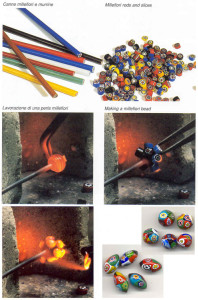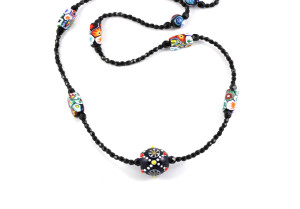WELCOME
Yes, one more added to the Virtual World of Blogs. Before starting to write, I went through an internal dialog, weighing the pros and the cons, because I used to look down at the idea of writing one. I thought that blogging was self-indulgent and presumptuous—the equivalent of Selfies of the visual social media. Who cares what one had for breakfast? Who cares about the minutia in other peoples’ life or their cliché thoughts? But then…I came across some thoughtful and informative blogs that left me thinking or gave me useful information.
I hope that mine will be a useful blog, one in which I‘ll share with you my knowledge of some aspects of jewelry.
BLOG #1 MILLEFIORI

 I decided to write my first blog about millefiori glass beads. I wonder if it is because I like the melodic sound of the word—it so Italian! Or, because I recently made a necklace using black millefiori beads, which I think are beautiful. (Judge for yourself.)
I decided to write my first blog about millefiori glass beads. I wonder if it is because I like the melodic sound of the word—it so Italian! Or, because I recently made a necklace using black millefiori beads, which I think are beautiful. (Judge for yourself.)
Millefiori means “thousand flowers” in English. The technique of creating a look of flowers embedded in glass involves the use of glass rods (canes) with multicolored pattern of flowers which can only be viewed from the end of the rod. Slices of such a rod are pressed into the surface of a bead, forming a desired pattern naturally when it is still hot. It is a labor-intensive technique, as each item is individually and painstakingly handmade.
Variations of the millefiori technique go back as far as the 7th century; until the 19th century, its products were referred to as Mosaic beads. When we use the term nowadays, we usually refer to the technique developed in Murano, Italy, around the 15th century.
You may see polymer clay beads made with this technique as well. Artists who love the look have been adapting it to this relatively new material.
BLOG #2 Beware
Years ago, before I ever thought about making jewelry, I was visiting Brazil. Naturally, I needed to buy gifts and looked for them wherever I went. One day, when I was in a store, my eyes caught a display of rocks. Since one of my kids was an avid rock collector, I was drawn to the display. I immediately noticed a beautiful royal blue stone whose shape looked like that of a half of an agate geode but whose color was different.
Knowing that agate geodes are usually light gray or light bluish-gray, I asked the proprietor what it was, and he told me that, indeed, it was an agate. Apparently seeing the disbelief on my face, he volunteered that “only in Brazil do we have this unusual color.” He repeated it several times, I believed him, and I bought it.
When I returned home, I was excited as I gave it to my son, who was skeptical and had to be convinced that it was a special and natural Brazilian agate. It turned out that my son was right! It was a dyed geode.
Nowadays, dyed beads and stones are everywhere and come from many countries. In fact, it is hard to find beads that are not colored in garish colors, polished excessively, or enhanced in one way or another.
After I started making jewelry several years later, I was “taken” again. Once, when I was shopping in a New York City bead shop, I discovered large and beautiful oval cherry color beads. They looked like quartz, transparent with cherry occlusions that made them look very pretty.
I had previously seen and used rose quartz, clear quartz, smoky quartz but not quartz in this color. When I asked the proprietor “what are they?” he answered “cherry quartz.” I immediately bought a few strands.
Over the next year, I didn’t see any other beads like them, which made me happy since I like to work with unique materials. However, when subsequently browsing in a trade magazine, I saw an ad for “man-made Cherry quartz beads.” I realized that the beads I had bought were imitation, made out of glass.
This didn’t change their beauty. I made a long, trendy necklace with them and since I liked it very much and needed that color for a new dress, I kept the necklace for myself! (I really don’t care what material the beads are made of as long as they are beautiful.)
So now you know that, if you see something called a “cherry quartz” necklace, it is not quartz. Similarly, if you see one made out of “Italian onyx,” it is Italian marble, and if you see “new jade,” it is not expensive antique jade but some sort of serpentine that comes from China or other countries and in the trade is called “new jade.”
There is a simple test which can help you decide if the jewelry you own or are considering is made of semiprecious beads. Squeeze the beads in your hand. If they feel cold to the touch, they are the real thing. If you are not sure how cold it should be, hold some plastic, maybe acrylic beads, in the other hand for comparison, you will feel the difference.
Dalia
© 2014 Elegant Jewelry by Dalia
BLOG #3 Jewelry’s Metals Explained
BLOG #3
Recently, I took out of a drawer a necklace which I had made and occasionally wear. To my surprise, I saw that the gold layer of the toggle fastener had started to wear off. I actually didn’t mind this fact much because it gave the fastener a Vintage look. However, some people would mind, and that gave me the idea of sharing with you some of my knowledge of the differences between gold plated, gold-filled, and other relevant metal terms.
GOLD PLATED
A jewelry item is “gold plated” when it has a layer of gold bonded electromagnetically to a base metal. The base metal, such as brass or steel, is dipped into a bath of an electroplating solution with a piece of solid gold. When electric current is applied, it causes a thin layer of gold to be deposited on the other metal. This method requires a standard of minimum thickness for the gold layer.
GOLD-FILLED
Gold-filled jewelry is also made of base metal–usually, brass or copper—but is covered with gold in a different bonding process than electroplating.
A gold-filled item usually has a mark indicating how much karat Gold it contains. If a piece of jewelry is marked, for example, 1/20 14K GF. It means that 5% of the total weight is 14K. gold. Such an item, with reasonable care, should last like any other 14K. jewelry.
GOLD FINISHED, GOLD WASH, GOLD COLORED
These terms would apply to thinner layers of coating and have no standard of thickness for the gold. There is no way of knowing how long the gold would last—it depends on the humidity in your area and the salt in the sweat of your neck. There, I said it!
VERMEIL
It is pronounced “vermay.” When you are told that a piece of jewelry is Vermeil, it means that the base metal for the jewelry is silver.
Since the price of gold has sky rocketed, I find that it is very hard to get precise information when I buy findings, the small parts used in jewelry making. Some items that used to be gold-plated are now just gold washed or, gold finished but are just as expensive. At times, when I buy them at jewelry shows, I have to trust the vendors and I am frequently not sure that I should.
**in my next BLOG I will cover silver and other metals,
Until then, Dalia
